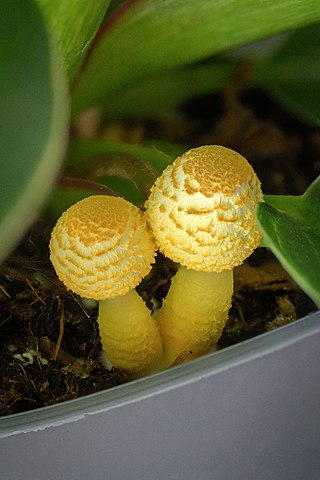
Lepiota is a genus of gilled mushrooms in the family Agaricaceae. All Lepiota species are ground-dwelling saprotrophs with a preference for rich, calcareous soils. Basidiocarps are agaricoid with whitish spores, typically with scaly caps and a ring on the stipe. Around 400 species of Lepiota are currently recognized worldwide. Many species are poisonous, some lethally so.

In the Baháʼí Faith there are two covenants, deemed the 'greater' and 'lesser'. The greater covenant refers to an agreement of progressive revelation: that God will send messengers about every thousand years, and it is humanity's duty to recognize them and respond to their teachings. The lesser covenant is the agreement between the faith's founder, Baháʼu'lláh, and his followers, regarding the succession of leadership and the maintenance of unity.

Leucocoprinus birnbaumii, commonly known as the flower pot parasol, yellow parasol, flowerpot parasol, or plantpot dapperling, is a species of gilled mushroom in the family Agaricaceae. It is common in the tropics and subtropics. However, in temperate regions, it frequently occurs in greenhouses and flowerpots, hence its common names of flowerpot parasol and plantpot dapperling. It is considered to be toxic if consumed.

Giacomo Bresadola 14 February 1847 – Trento 9 June 1929) was an eminent Italian mycologist. Fungi he named include the deadly Lepiota helveola and Inocybe patouillardii, though the latter is now known as Inosperma erubescens as this latter description predated Bresadola's by a year. He was a founding member of the Société mycologique de France.

Leucocoprinus fragilissimus, commonly known as the fragile dapperling, is a species of gilled mushroom in the family Agaricaceae.

Discina fastigiata is a species of fungus in the family Discinaceae. Its common names are brown false morel and brown gyromitra. It is related to species containing the toxin monomethylhydrazine, so its consumption is not advised.

Lepiota cristata, commonly known as the stinking dapperling, brown-eyed parasol, or the stinking parasol, is an agaric and possibly poisonous mushroom in the family Agaricaceae. A common and widespread species—one of the most widespread fungi in the genus Lepiota—it has been reported from Europe, northern Asia, North America, and New Zealand. It fruits on the ground in disturbed areas, such as lawns, path and road edges, parks, and gardens. The species produces fruit bodies characterized by the flat, reddish-brown concentric scales on the caps, and an unpleasant odour resembling burnt rubber. Similar Lepiota species can sometimes be distinguished from L. cristata by differences in cap colour, stipe structure, or odour, although some species can only be reliably distinguished through the use of microscopy.

Leucoagaricus erythrophaeus is a species of agaric fungus. Described as new to science in 2010, it is found in California, where it grows in mixed forest. The specific epithet erythrophaeus originates from the Greek words ερυ𝛉ρος and ϕαιος ("dark"), and refers to the mushroom's characteristic bruising reaction. The species was formerly known under the misapplied name Lepiota roseifolia.

Telekia speciosa, also known as the heart-leaved oxeye or yellow oxeye, is a species of flowering plant within the family Asteraceae.

Leucoagaricus meleagris is a species of fungus in the family Agaricaceae.
Leucocoprinus beelianus is a species of mushroom producing fungus in the family Agaricaceae.
John Errol Chandos Aberdeen was an Australian botanist, mycologist and agricultural scientist.
Leucocoprinus thoenii is a species of mushroom producing fungus in the family Agaricaceae.
Leucocoprinus submontagnei is a species of mushroom producing fungus in the family Agaricaceae.

Macrolepiota zeyheri is a species of mushroom producing fungus in the family Agaricaceae. In the Kilendu dialect it is known as djilo and in the Kilur dialect it is called n'volo mighom.
Leucocoprinus viridiflavus is a species of mushroom producing fungus in the family Agaricaceae. It may also be known as Leucoagaricus viridiflavus.
Leucocoprinus viridiflavoides is a species of mushroom producing fungus in the family Agaricaceae. It may still be known as Leucoagaricus viridiflavoides.











